instrument panel TOYOTA YARIS 2017 Owners Manual
[x] Cancel search | Manufacturer: TOYOTA, Model Year: 2017, Model line: YARIS, Model: TOYOTA YARIS 2017Pages: 549, PDF Size: 33.09 MB
Page 12 of 549
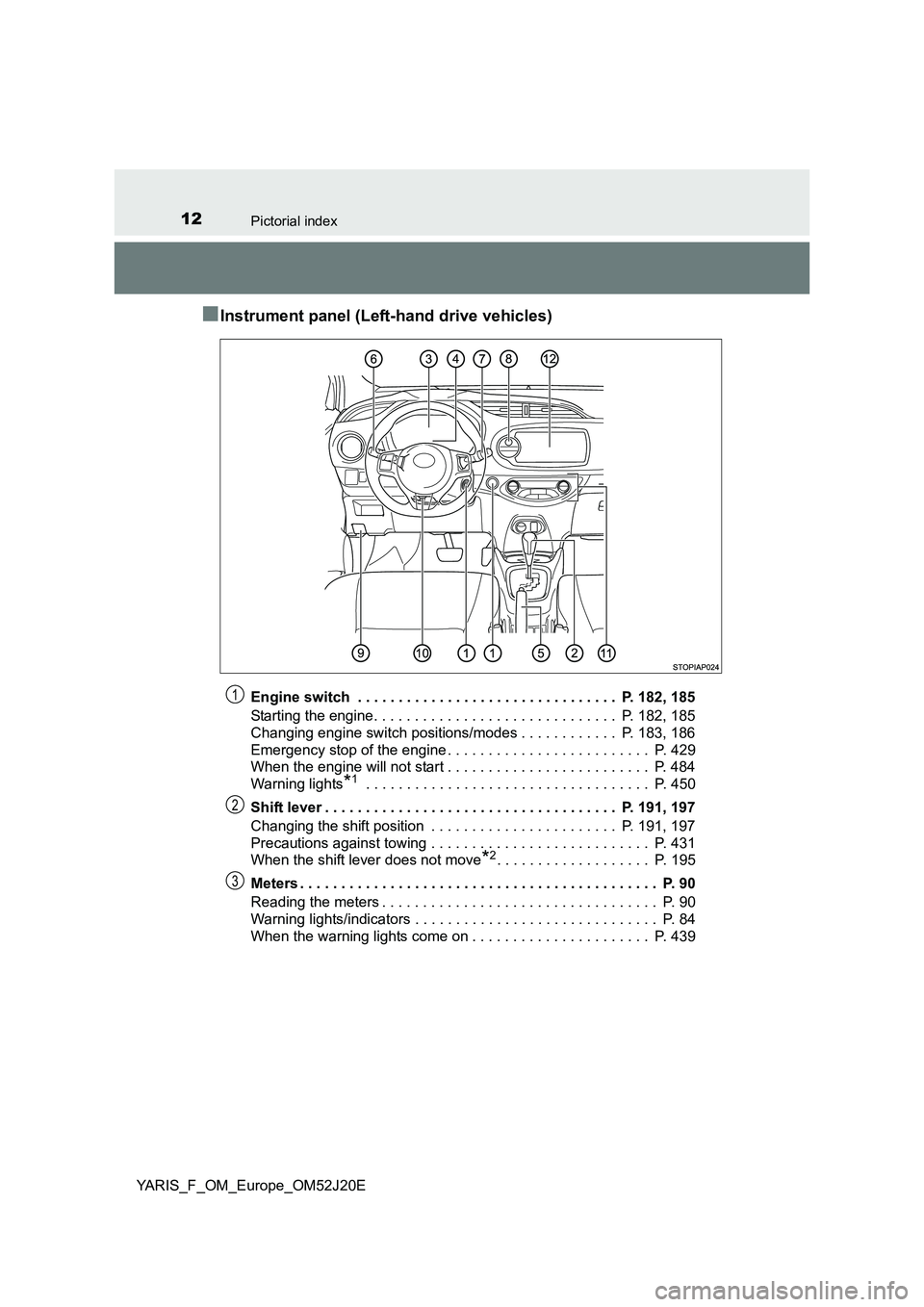
12Pictorial index
YARIS_F_OM_Europe_OM52J20E
■Instrument panel (Left-hand drive vehicles)
Engine switch . . . . . . . . . . . . . . . . . . . . . . . . . . . . . . . . P. 182, 185
Starting the engine. . . . . . . . . . . . . . . . . . . . . . . . . . . . . . P. 182, 185
Changing engine switch positions/modes . . . . . . . . . . . . P. 183, 186
Emergency stop of the engine . . . . . . . . . . . . . . . . . . . . . . . . . P. 429
When the engine will not start . . . . . . . . . . . . . . . . . . . . . . . . . P. 484
Warning lights*1 . . . . . . . . . . . . . . . . . . . . . . . . . . . . . . . . . . . P. 450
Shift lever . . . . . . . . . . . . . . . . . . . . . . . . . . . . . . . . . . . . P. 191, 197
Changing the shift position . . . . . . . . . . . . . . . . . . . . . . . P. 191, 197
Precautions against towing . . . . . . . . . . . . . . . . . . . . . . . . . . . P. 431
When the shift lever does not move*2. . . . . . . . . . . . . . . . . . . P. 195
Meters . . . . . . . . . . . . . . . . . . . . . . . . . . . . . . . . . . . . . . . . . . . . P. 90
Reading the meters . . . . . . . . . . . . . . . . . . . . . . . . . . . . . . . . . . P. 90
Warning lights/indicators . . . . . . . . . . . . . . . . . . . . . . . . . . . . . . P. 84
When the warning lights come on . . . . . . . . . . . . . . . . . . . . . . P. 439
1
2
3
Page 19 of 549
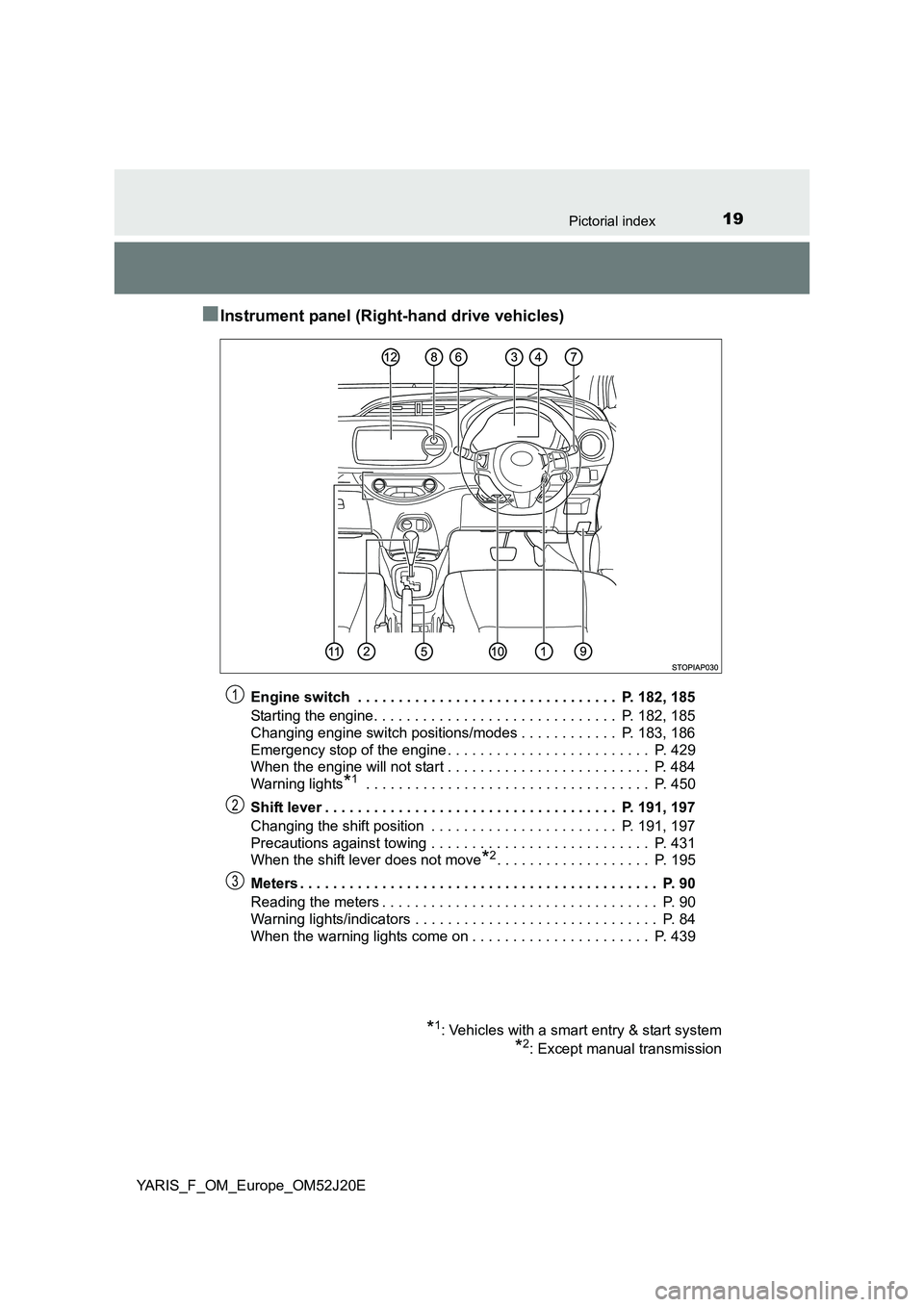
19Pictorial index
YARIS_F_OM_Europe_OM52J20E
■Instrument panel (Right-hand drive vehicles)
Engine switch . . . . . . . . . . . . . . . . . . . . . . . . . . . . . . . . P. 182, 185
Starting the engine. . . . . . . . . . . . . . . . . . . . . . . . . . . . . . P. 182, 185
Changing engine switch positions/modes . . . . . . . . . . . . P. 183, 186
Emergency stop of the engine . . . . . . . . . . . . . . . . . . . . . . . . . P. 429
When the engine will not start . . . . . . . . . . . . . . . . . . . . . . . . . P. 484
Warning lights*1 . . . . . . . . . . . . . . . . . . . . . . . . . . . . . . . . . . . P. 450
Shift lever . . . . . . . . . . . . . . . . . . . . . . . . . . . . . . . . . . . . P. 191, 197
Changing the shift position . . . . . . . . . . . . . . . . . . . . . . . P. 191, 197
Precautions against towing . . . . . . . . . . . . . . . . . . . . . . . . . . . P. 431
When the shift lever does not move*2. . . . . . . . . . . . . . . . . . . P. 195
Meters . . . . . . . . . . . . . . . . . . . . . . . . . . . . . . . . . . . . . . . . . . . . P. 90
Reading the meters . . . . . . . . . . . . . . . . . . . . . . . . . . . . . . . . . . P. 90
Warning lights/indicators . . . . . . . . . . . . . . . . . . . . . . . . . . . . . . P. 84
When the warning lights come on . . . . . . . . . . . . . . . . . . . . . . P. 439
*1: Vehicles with a smart entry & start system
*2: Except manual transmission
1
2
3
Page 43 of 549
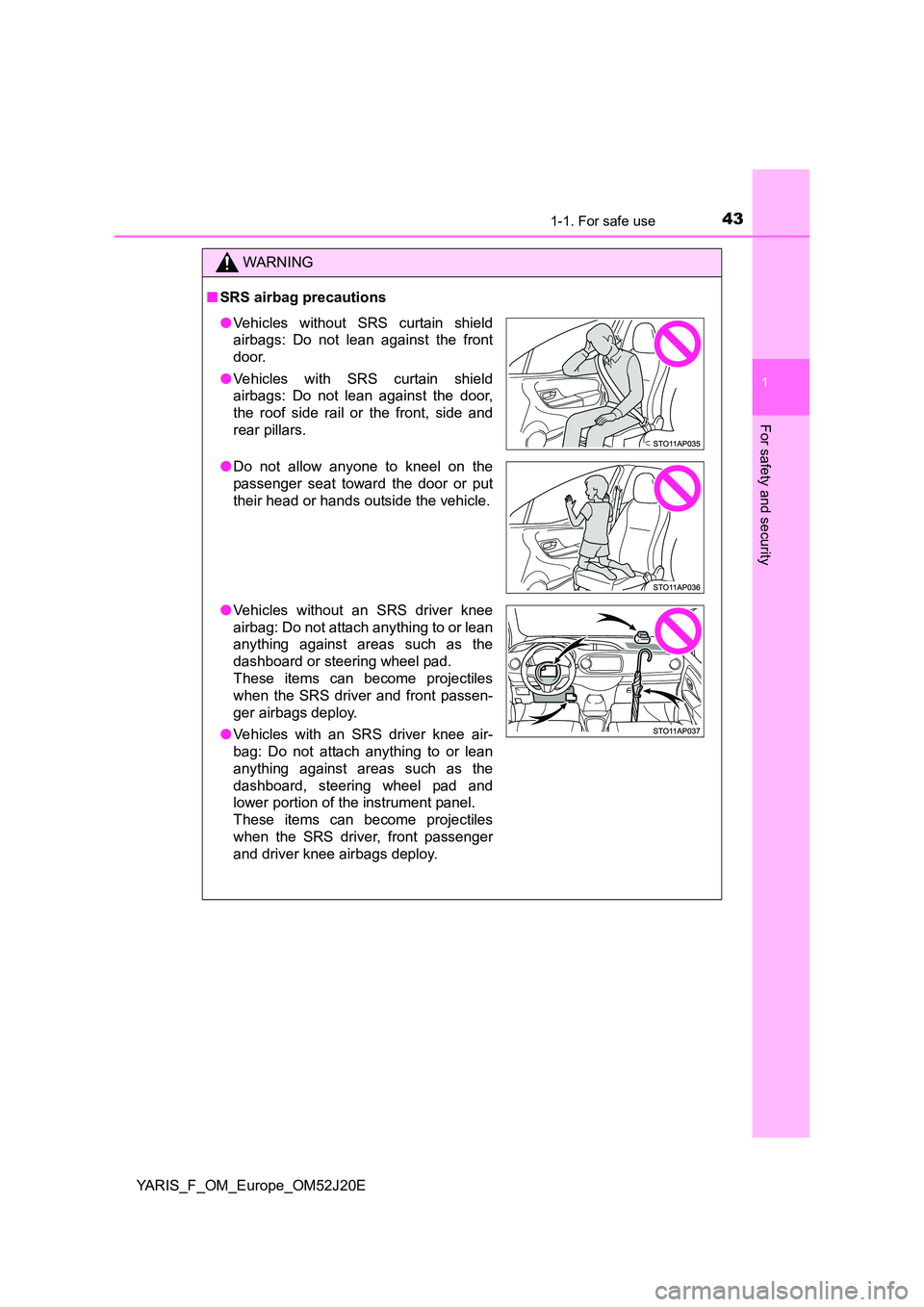
431-1. For safe use
1
For safety and security
YARIS_F_OM_Europe_OM52J20E
WARNING
■SRS airbag precautions
●Vehicles without SRS curtain shield
airbags: Do not lean against the front
door.
● Vehicles with SRS curtain shield
airbags: Do not lean against the door,
the roof side rail or the front, side and
rear pillars.
● Do not allow anyone to kneel on the
passenger seat toward the door or put
their head or hands outside the vehicle.
● Vehicles without an SRS driver knee
airbag: Do not attach anything to or lean
anything against areas such as the
dashboard or steering wheel pad.
These items can become projectiles
when the SRS driver and front passen-
ger airbags deploy.
● Vehicles with an SRS driver knee air-
bag: Do not attach anything to or lean
anything against areas such as the
dashboard, steering wheel pad and
lower portion of the instrument panel.
These items can become projectiles
when the SRS driver, front passenger
and driver knee airbags deploy.
Page 45 of 549
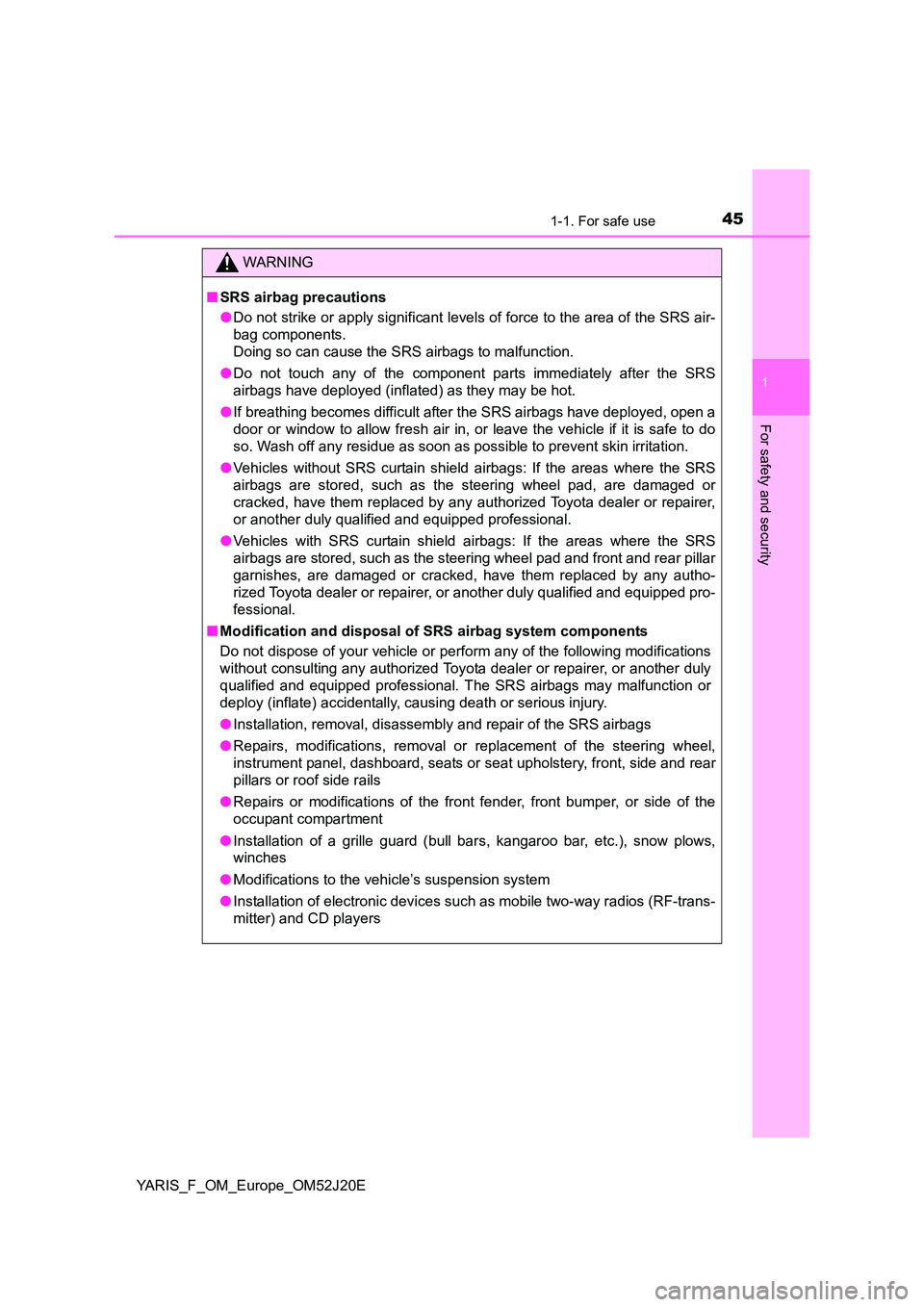
451-1. For safe use
1
For safety and security
YARIS_F_OM_Europe_OM52J20E
WARNING
■SRS airbag precautions
● Do not strike or apply significant levels of force to the area of the SRS air-
bag components.
Doing so can cause the SRS airbags to malfunction.
● Do not touch any of the component parts immediately after the SRS
airbags have deployed (inflated) as they may be hot.
● If breathing becomes difficult after the SRS airbags have deployed, open a
door or window to allow fresh air in, or leave the vehicle if it is safe to do
so. Wash off any residue as soon as possible to prevent skin irritation.
● Vehicles without SRS curtain shield airbags: If the areas where the SRS
airbags are stored, such as the steering wheel pad, are damaged or
cracked, have them replaced by any authorized Toyota dealer or repairer,
or another duly qualified and equipped professional.
● Vehicles with SRS curtain shield airbags: If the areas where the SRS
airbags are stored, such as the steer ing wheel pad and front and rear pillar
garnishes, are damaged or cracked, have them replaced by any autho-
rized Toyota dealer or repairer, or another duly qualified and equipped pro-
fessional.
■ Modification and disposal of SRS airbag system components
Do not dispose of your vehicle or perform any of the following modifications
without consulting any authorized Toyota dealer or repairer, or another duly
qualified and equipped professional. The SRS airbags may malfunction or
deploy (inflate) accidentally, causing death or serious injury.
● Installation, removal, disassembly and repair of the SRS airbags
● Repairs, modifications, removal or replacement of the steering wheel,
instrument panel, dashboard, seats or seat upholstery, front, side and rear
pillars or roof side rails
● Repairs or modifications of the front fender, front bumper, or side of the
occupant compartment
● Installation of a grille guard (bull bars, kangaroo bar, etc.), snow plows,
winches
● Modifications to the vehicle’s suspension system
● Installation of electronic devices such as mobile two-way radios (RF-trans-
mitter) and CD players
Page 49 of 549
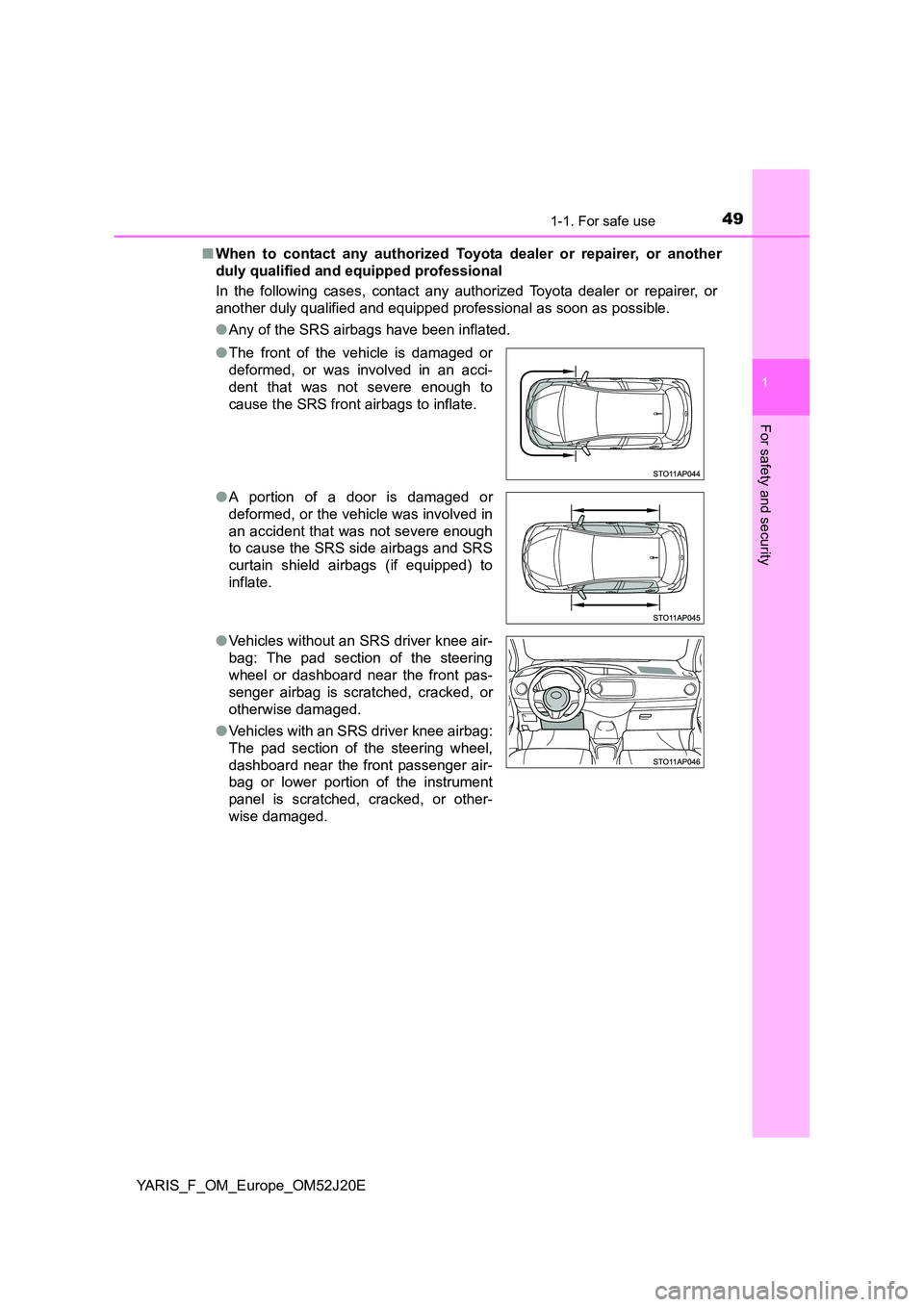
491-1. For safe use
1
For safety and security
YARIS_F_OM_Europe_OM52J20E
■ When to contact any authorized Toyota dealer or repairer, or another
duly qualified and equipped professional
In the following cases, contact any authorized Toyota dealer or repairer, or
another duly qualified and equipped professional as soon as possible.
● Any of the SRS airbags have been inflated.
● The front of the vehicle is damaged or
deformed, or was involved in an acci-
dent that was not severe enough to
cause the SRS front airbags to inflate.
● A portion of a door is damaged or
deformed, or the vehicle was involved in
an accident that was not severe enough
to cause the SRS side airbags and SRS
curtain shield airbags (if equipped) to
inflate.
● Vehicles without an SRS driver knee air-
bag: The pad section of the steering
wheel or dashboard near the front pas-
senger airbag is scratched, cracked, or
otherwise damaged.
● Vehicles with an SRS driver knee airbag:
The pad section of the steering wheel,
dashboard near the front passenger air-
bag or lower portion of the instrument
panel is scratched, cracked, or other-
wise damaged.
Page 84 of 549
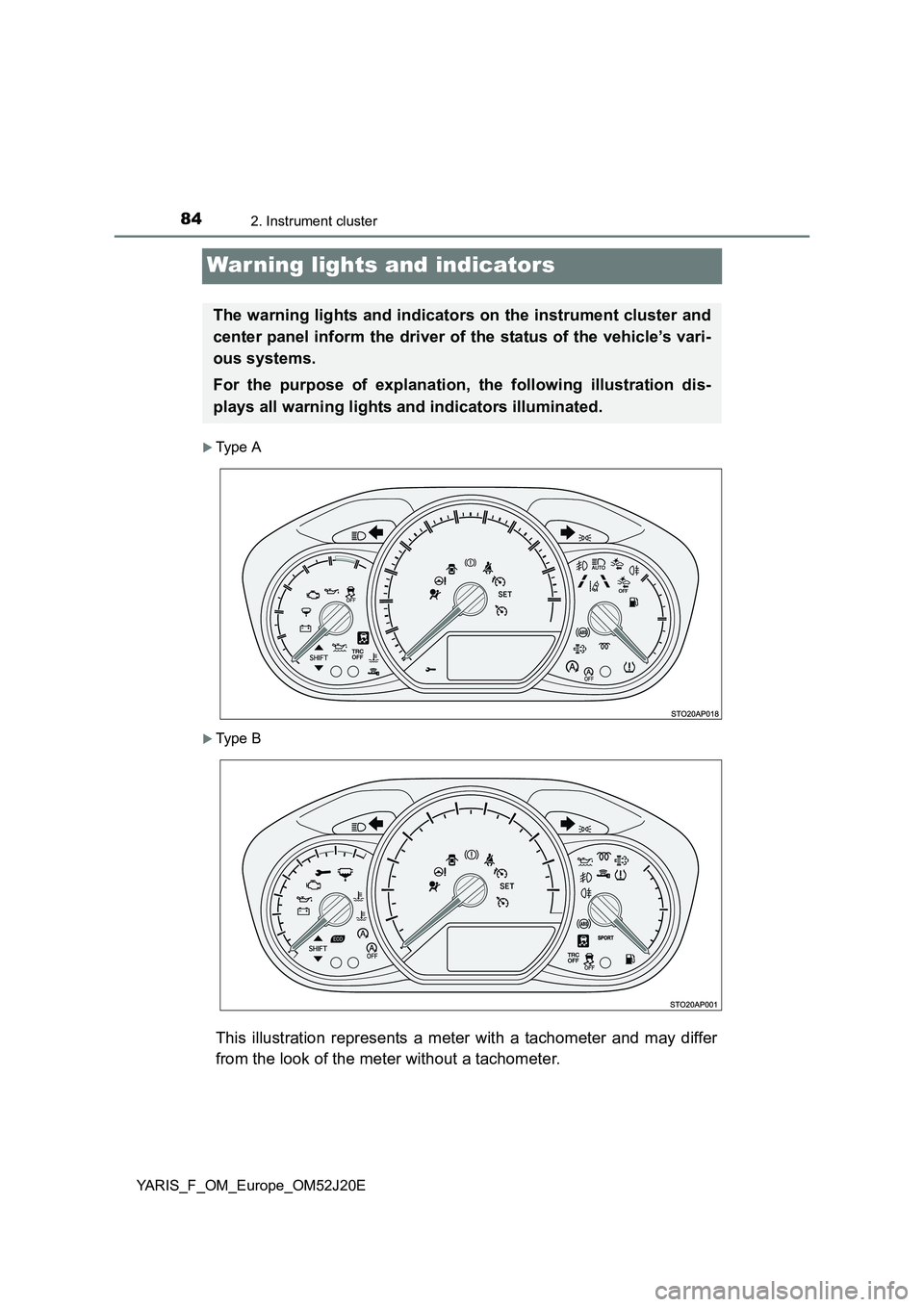
842. Instrument cluster
YARIS_F_OM_Europe_OM52J20E
War ning lights and indicators
Type A
Type B
This illustration represents a meter with a tachometer and may differ
from the look of the meter without a tachometer.
The warning lights and indicators on the instrument cluster and
center panel inform the driver of the status of the vehicle’s vari-
ous systems.
For the purpose of explanation, the following illustration dis-
plays all warning lights and indicators illuminated.
Page 86 of 549
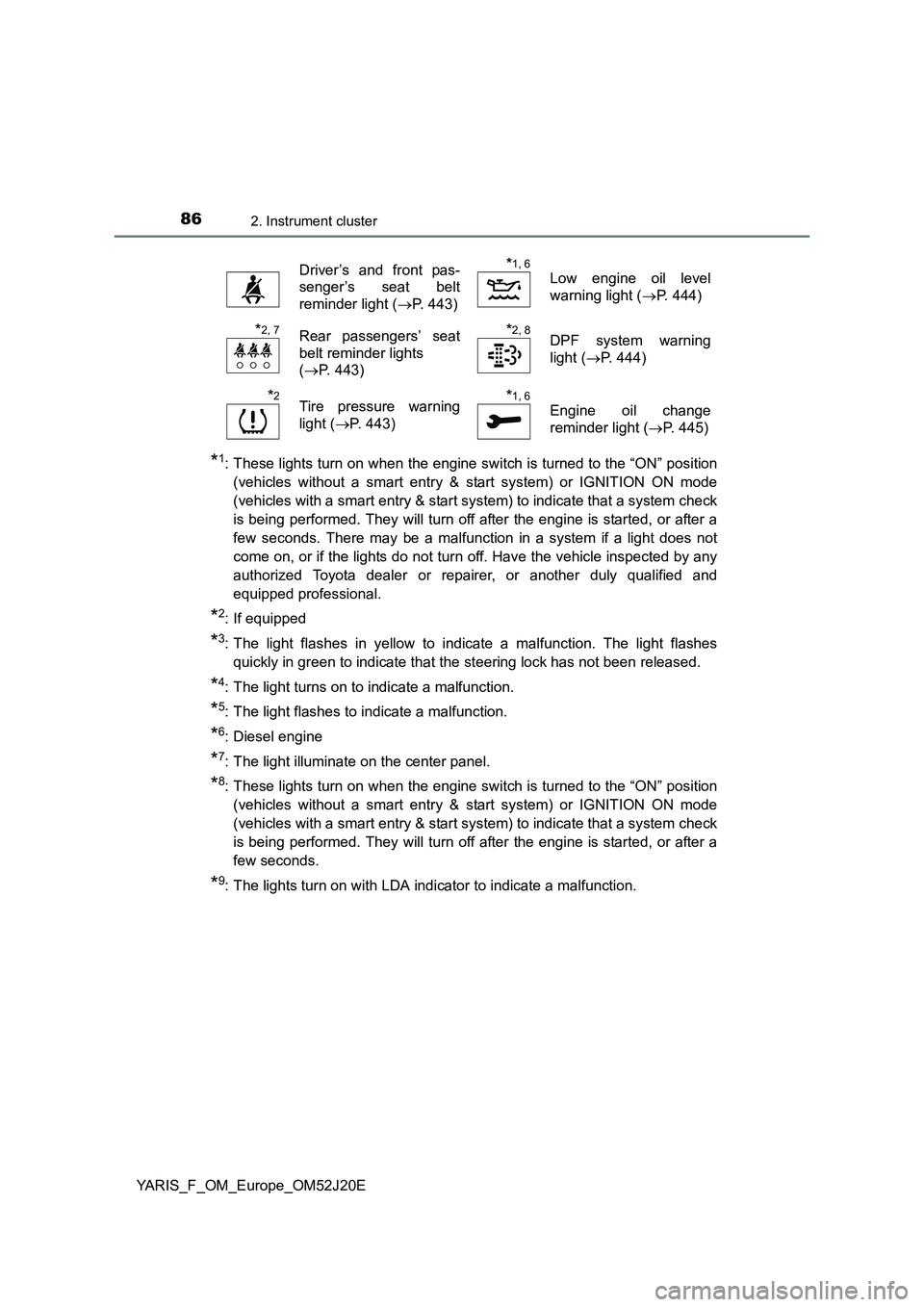
862. Instrument cluster
YARIS_F_OM_Europe_OM52J20E
*1: These lights turn on when the engine switch is turned to the “ON” position
(vehicles without a smart entry & start system) or IGNITION ON mode
(vehicles with a smart entry & start system) to indicate that a system check
is being performed. They will turn off after the engine is started, or after a
few seconds. There may be a malfunction in a system if a light does not
come on, or if the lights do not turn off. Have the vehicle inspected by any
authorized Toyota dealer or repairer, or another duly qualified and
equipped professional.
*2: If equipped
*3: The light flashes in yellow to indicate a malfunction. The light flashes
quickly in green to indicate that the steering lock has not been released.
*4: The light turns on to indicate a malfunction.
*5: The light flashes to indicate a malfunction.
*6: Diesel engine
*7: The light illuminate on the center panel.
*8: These lights turn on when the engine switch is turned to the “ON” position
(vehicles without a smart entry & start system) or IGNITION ON mode
(vehicles with a smart entry & start system) to indicate that a system check
is being performed. They will turn off after the engine is started, or after a
few seconds.
*9: The lights turn on with LDA indicator to indicate a malfunction.
Driver’s and front pas-
senger’s seat belt
reminder light ( P. 443)
*1, 6
Low engine oil level
warning light ( P. 444)
*2, 7Rear passengers’ seat
belt reminder lights
( P. 443)
*2, 8DPF system warning
light ( P. 444)
*2Tire pressure warning
light ( P. 443)
*1, 6
Engine oil change
reminder light ( P. 445)
Page 88 of 549
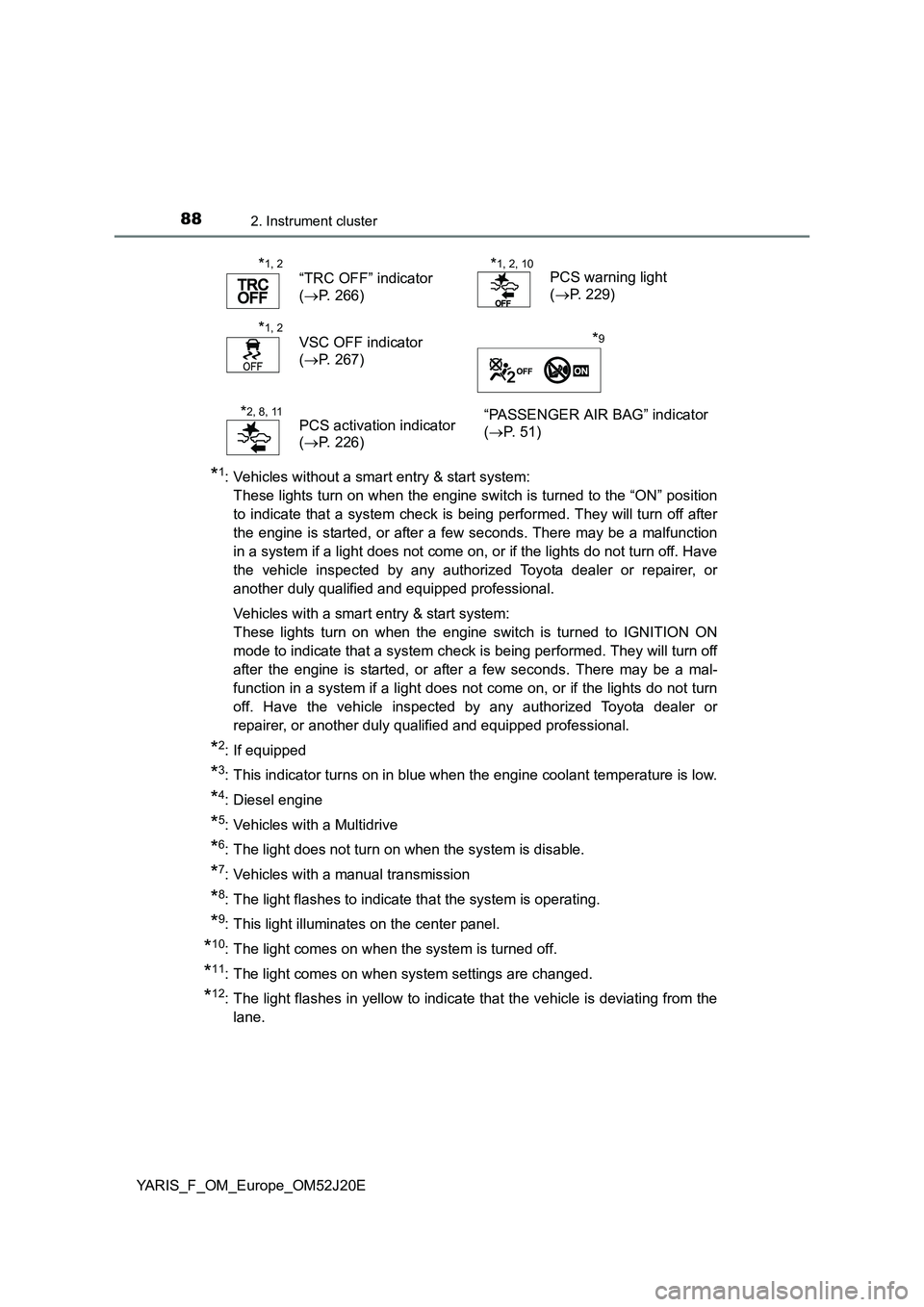
882. Instrument cluster
YARIS_F_OM_Europe_OM52J20E
*1: Vehicles without a smart entry & start system:
These lights turn on when the engine switch is turned to the “ON” position
to indicate that a system check is being performed. They will turn off after
the engine is started, or after a few seconds. There may be a malfunction
in a system if a light does not come on, or if the lights do not turn off. Have
the vehicle inspected by any authorized Toyota dealer or repairer, or
another duly qualified and equipped professional.
Vehicles with a smart entry & start system:
These lights turn on when the engine switch is turned to IGNITION ON
mode to indicate that a system check is being performed. They will turn off
after the engine is started, or after a few seconds. There may be a mal-
function in a system if a light does not come on, or if the lights do not turn
off. Have the vehicle inspected by any authorized Toyota dealer or
repairer, or another duly qualified and equipped professional.
*2: If equipped
*3: This indicator turns on in blue when the engine coolant temperature is low.
*4: Diesel engine
*5: Vehicles with a Multidrive
*6: The light does not turn on when the system is disable.
*7: Vehicles with a manual transmission
*8: The light flashes to indicate that the system is operating.
*9: This light illuminates on the center panel.
*10: The light comes on when the system is turned off.
*11: The light comes on when system settings are changed.
*12: The light flashes in yellow to indicate that the vehicle is deviating from the
lane.
*1, 2
“TRC OFF” indicator
( P. 266)
*1, 2, 10PCS warning light
( P. 229)
*1, 2
VSC OFF indicator
( P. 267)
*9
*2, 8, 11PCS activation indicator
( P. 226)
“PASSENGER AIR BAG” indicator
( P. 51)
Page 91 of 549
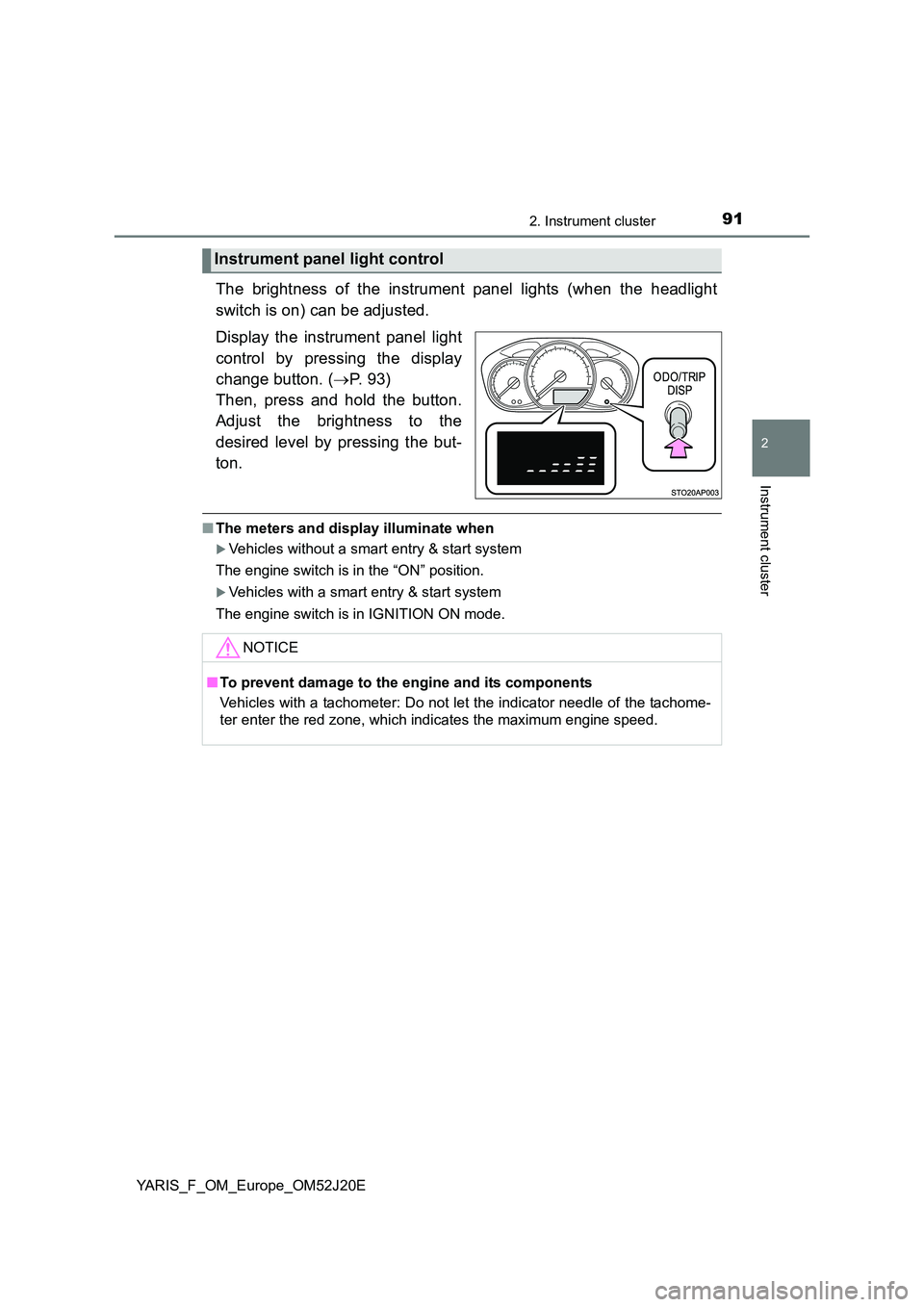
912. Instrument cluster
2
Instrument cluster
YARIS_F_OM_Europe_OM52J20E
The brightness of the instrument panel lights (when the headlight
switch is on) can be adjusted.
Display the instrument panel light
control by pressing the display
change button. ( P. 93)
Then, press and hold the button.
Adjust the brightness to the
desired level by pressing the but-
ton.
■ The meters and display illuminate when
Vehicles without a smart entry & start system
The engine switch is in the “ON” position.
Vehicles with a smart entry & start system
The engine switch is in IGNITION ON mode.
Instrument panel light control
NOTICE
■ To prevent damage to the engine and its components
Vehicles with a tachometer: Do not let the indicator needle of the tachome-
ter enter the red zone, which indicates the maximum engine speed.
Page 131 of 549
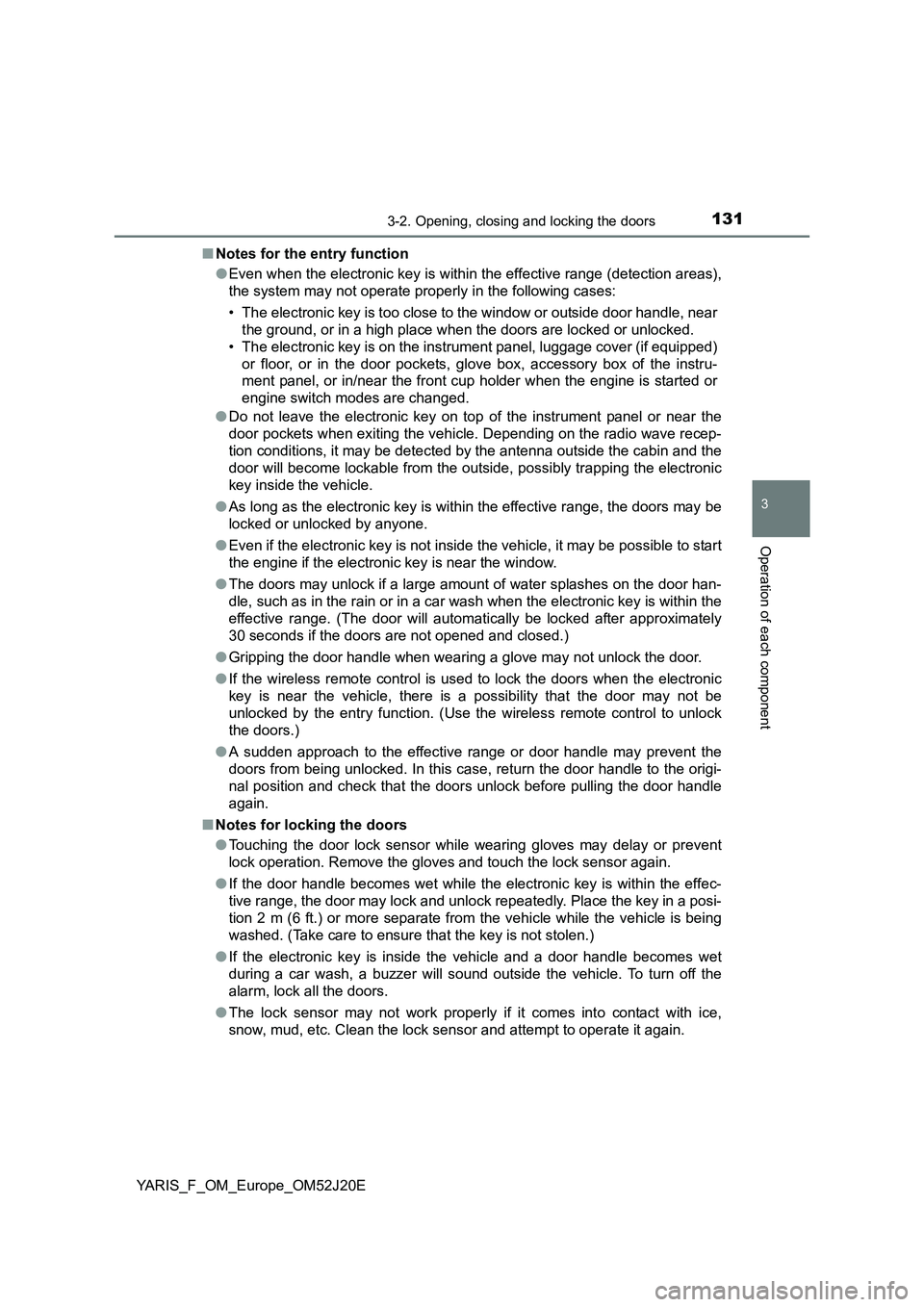
1313-2. Opening, closing and locking the doors
3
Operation of each component
YARIS_F_OM_Europe_OM52J20E
■ Notes for the entry function
● Even when the electronic key is within the effective range (detection areas),
the system may not operate properly in the following cases:
• The electronic key is too close to the window or outside door handle, near
the ground, or in a high place w hen the doors are locked or unlocked.
• The electronic key is on the inst rument panel, luggage cover (if equipped)
or floor, or in the door pockets, glove box, accessory box of the instru-
ment panel, or in/near the front cup holder when the engine is started or
engine switch modes are changed.
● Do not leave the electronic key on top of the instrument panel or near the
door pockets when exiting the vehicle. Depending on the radio wave recep-
tion conditions, it may be detected by the antenna outside the cabin and the
door will become lockable from the outside, possibly trapping the electronic
key inside the vehicle.
● As long as the electronic key is within the effective range, the doors may be
locked or unlocked by anyone.
● Even if the electronic key is not inside the vehicle, it may be possible to start
the engine if the electronic key is near the window.
● The doors may unlock if a large amount of water splashes on the door han-
dle, such as in the rain or in a car wash when the electronic key is within the
effective range. (The door will automatically be locked after approximately
30 seconds if the doors are not opened and closed.)
● Gripping the door handle when wearing a glove may not unlock the door.
● If the wireless remote control is used to lock the doors when the electronic
key is near the vehicle, there is a possibility that the door may not be
unlocked by the entry function. (Use the wireless remote control to unlock
the doors.)
● A sudden approach to the effective range or door handle may prevent the
doors from being unlocked. In this case, return the door handle to the origi-
nal position and check that the doors unlock before pulling the door handle
again.
■ Notes for locking the doors
● Touching the door lock sensor while wearing gloves may delay or prevent
lock operation. Remove the gloves and touch the lock sensor again.
● If the door handle becomes wet while the electronic key is within the effec-
tive range, the door may lock and unlock repeatedly. Place the key in a posi-
tion 2 m (6 ft.) or more separate from the vehicle while the vehicle is being
washed. (Take care to ensure that the key is not stolen.)
● If the electronic key is inside the vehicle and a door handle becomes wet
during a car wash, a buzzer will sound outside the vehicle. To turn off the
alarm, lock all the doors.
● The lock sensor may not work properly if it comes into contact with ice,
snow, mud, etc. Clean the lock sensor and attempt to operate it again.